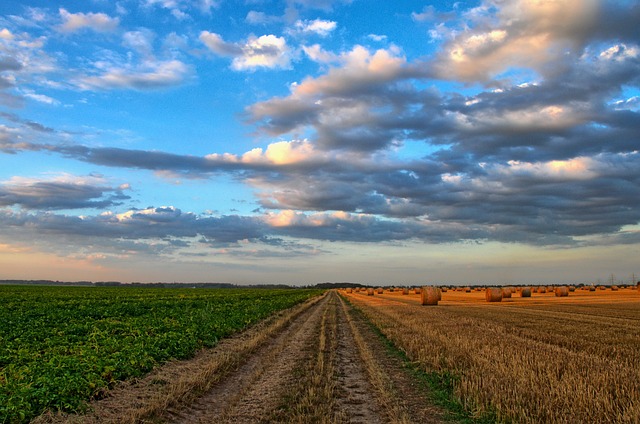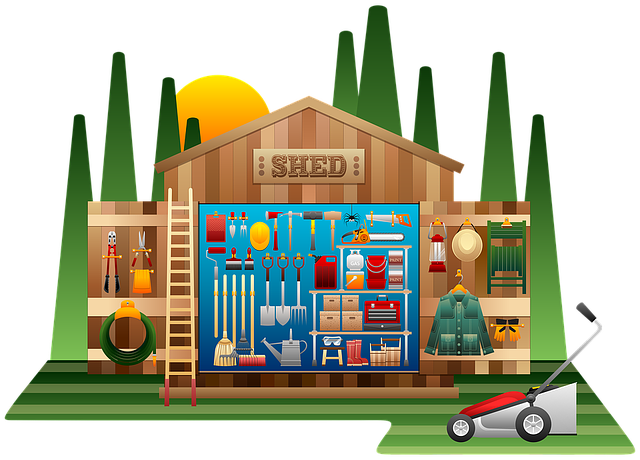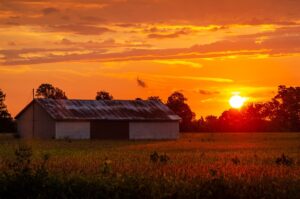2023 has marked a significant evolution in farm shed design within Wagga Wagga's agricultural sector, addressing the unique climatic challenges of its semi-arid environment, characterized by hot summers and cool winters. The latest farm sheds are engineered to withstand extreme temperatures, variable rainfall, and strong winds, incorporating features like effective ventilation, insulation, and UV-resistant materials. These structures are also designed with advanced roofing for efficient rainwater collection, a critical aspect for sustainable farming operations. The integration of renewable energy solutions such as solar panels further minimizes the environmental impact of rural activities. Local constructors have innovated, using steel for its durability and resilience, and applying protective coatings to combat rust and corrosion. Aerodynamic designs reduce wind impact and safeguard against storms, while inside, energy-efficient measures ensure a comfortable environment for both humans and sensitive equipment. The customization of these farm sheds is tailored to specific agricultural needs, enhancing functionality and efficiency. This transformation in farm shed design positions them as indispensable assets for modern farming, aligning with sustainability goals and offering farmers in Wagga Wagga a competitive edge through reduced operational costs and a smaller carbon footprint. These advancements underscore the critical role of farm sheds in optimizing farm efficiency and productivity amidst the region's environmental variability.
Exploring the resilient architecture of farm sheds tailored for Wagga Wagga’s unique climate, this article delves into the pivotal design considerations and robust construction techniques that ensure these structures stand strong against the region’s variable weather conditions. From selecting durable materials to customizing layouts for maximum efficiency, each aspect is carefully examined within the context of Wagga agriculture. With case studies highlighting successful implementations, readers will gain valuable insights into optimizing farm sheds for this dynamic environment.
- Understanding the Wagga Weather: A Climate Overview for Effective Farm Shed Design
- Durable Materials and Techniques: Constructing Farm Sheds to Withstand the Wagga Environment
- Customization Meets Efficiency: Tailoring Farm Sheds for Optimal Functionality in Wagga Agriculture
- Case Studies: Successful Farm Shed Implementations in Wagga Wagga's Agricultural Sector
Understanding the Wagga Weather: A Climate Overview for Effective Farm Shed Design

Situated in the Riverina region of New South Wales, Australia, Wagga Wagga experiences a typically semi-arid climate characterized by hot summers, mild to warm autumns, and cool winters. Understanding this unique weather pattern is crucial for designing farm sheds that withstand the elements while facilitating efficient agricultural operations. The region’s farm sheds must be robust enough to endure extreme temperatures, variable rainfall, and strong winds common to the area. The design of these structures should incorporate adequate ventilation and insulation to manage both the scorching heat during summer and the cold snaps that can occur in winter. This climate-smart approach ensures that farm activities are not hindered by weather conditions, allowing for year-round productivity.
Furthermore, the predictable yet variable nature of Wagga’s weather necessitates farm sheds with versatile design features. These include durable materials resistant to the sun’s UV rays, materials that can handle potential hail or storm damage, and roof designs that efficiently channel rainwater for agricultural use. Additionally, the integration of sustainable practices, such as solar panels on sheds, can help mitigate the impact of energy consumption in these rural settings. By aligning farm shed design with the local climate, farmers in Wagga Wagga can protect their assets and maximize their yield, ensuring the longevity and efficiency of their operations amidst the ever-changing weather patterns characteristic of the region.
Durable Materials and Techniques: Constructing Farm Sheds to Withstand the Wagga Environment

In the region surrounding Wagga Wagga, New South Wales, farm sheds are subject to a diverse array of climatic conditions, ranging from intense heat and drought to heavy rainfall and strong winds. To withstand these elements, local farm shed constructors employ durable materials and innovative techniques that ensure longevity and resistance to environmental stressors. Steel remains the material of choice due to its robustness and low maintenance requirements, capable of resisting the harsh UV rays characteristic of the Wagga weather. The integration of high-tensile bolts and corrosion-resistant coatings further enhances the sheds’ structural integrity against potential rust and corrosion. Additionally, strategic planning in design incorporates aerodynamic features to minimize wind impact and prevent damage during severe storms.
The construction process also integrates advanced techniques such as energy-efficient insulation to maintain interior temperatures within comfortable ranges, essential for both human occupants and temperature-sensitive equipment. Roofing materials are selected not only for their durability but also for their effectiveness in channeling rainwater into gutters, a critical feature in the water-prone regions of Wagga. Moreover, the implementation of skylights with UV protection allows natural light to penetrate while shielding against the damaging effects of direct sunlight. These farm sheds are tailored not only to safeguard agricultural machinery and stock but also to adapt to the dynamic environmental conditions of the Wagga region, ensuring they serve as reliable assets for farmers throughout the year.
Customization Meets Efficiency: Tailoring Farm Sheds for Optimal Functionality in Wagga Agriculture

In the agricultural heartland of Wagga Wagga, the quest for robust and adaptable farm sheds has led to a convergence of customization and efficiency. Local farmers are increasingly turning to bespoke solutions that cater specifically to the demanding climatic conditions of the region. These farm sheds are meticulously designed to withstand the variable weather patterns characteristic of Wagga, which range from severe heatwaves to unpredictable downpours. The integration of advanced materials and innovative engineering ensures that these structures not only endure but also enhance productivity on the farm.
The customization process begins with a thorough assessment of each farmer’s unique requirements. This includes considerations such as the type of crops or livestock, the scale of operation, and specific storage needs. The result is a farm shed that is optimized for functionality, providing shelter and protection that aligns seamlessly with the day-to-day operations on the farm. Energy efficiency is another cornerstone of these designs, with features such as insulation, ventilation, and strategic orientation to the sun all contributing to a reduction in energy consumption. This not only lowers operational costs but also minimizes the environmental footprint of farming activities in the region, aligning with the broader sustainability goals of Wagga’s agricultural sector. Farmers in Wagga are recognizing the dual benefits of these farm sheds: they are both custom-tailored to their specific needs and designed for optimal efficiency, ensuring that their investments are both practical and long-lasting.
Case Studies: Successful Farm Shed Implementations in Wagga Wagga's Agricultural Sector

In recent years, the agricultural sector in Wagga Wagga has seen a remarkable transformation through the implementation of farm sheds tailored to the region’s unique climatic conditions, known as the “Wagga Weather.” These structures have been instrumental in enhancing the efficiency and productivity of local farms. For instance, a case study involving a leading dairy operation in the area highlighted how strategically designed farm sheds provided a controlled environment for milk production, minimizing the effects of extreme temperatures and harsh weather patterns. The sheds featured advanced insulation, natural ventilation systems, and solar panels, which not only protected the animals but also reduced operational costs. Furthermore, the implementation of these sheds allowed for year-round grazing, leading to a consistent supply chain and improved herd health.
Another notable case study is that of a prominent grain farmer who adopted a state-of-the-art farm shed system. This system incorporated automated monitoring and adaptive climate control technology, ensuring optimal grain storage conditions. The result was significantly lower rates of spoilage, higher yields, and a more sustainable farming practice. These examples underscore the importance of farm sheds in adapting to and mitigating the challenges posed by Wagga’s variable weather, demonstrating their role as a cornerstone of modern agricultural innovation in the region. Farmers in Wagga Wagga are increasingly recognizing the benefits of these structures for crop and livestock management, with many investing in farm sheds to enhance their operations and adapt to the evolving demands of the industry.
In conclusion, Wagga Wagga’s distinctive weather patterns necessitate robust and thoughtfully designed farm sheds that stand up to the test of time. By understanding the local climate and employing durable materials and advanced construction techniques tailored specifically for this region, farmers in Wagga can ensure their agricultural operations remain protected and efficient. The case studies highlighted in this article demonstrate the real-world success of these strategies, underscoring the importance of customization and innovation in farm shed design. As a result, the farms in Wagga are better equipped to handle the challenges brought forth by their unique weather conditions, securing their position at the forefront of agricultural productivity within New South Wales. Farmers looking to invest in or construct new sheds should consider these insights to optimize their storage and operational needs, ultimately benefiting from farm structures that are both resilient and adaptable to the ever-changing demands of agriculture in Wagga’s environment.
